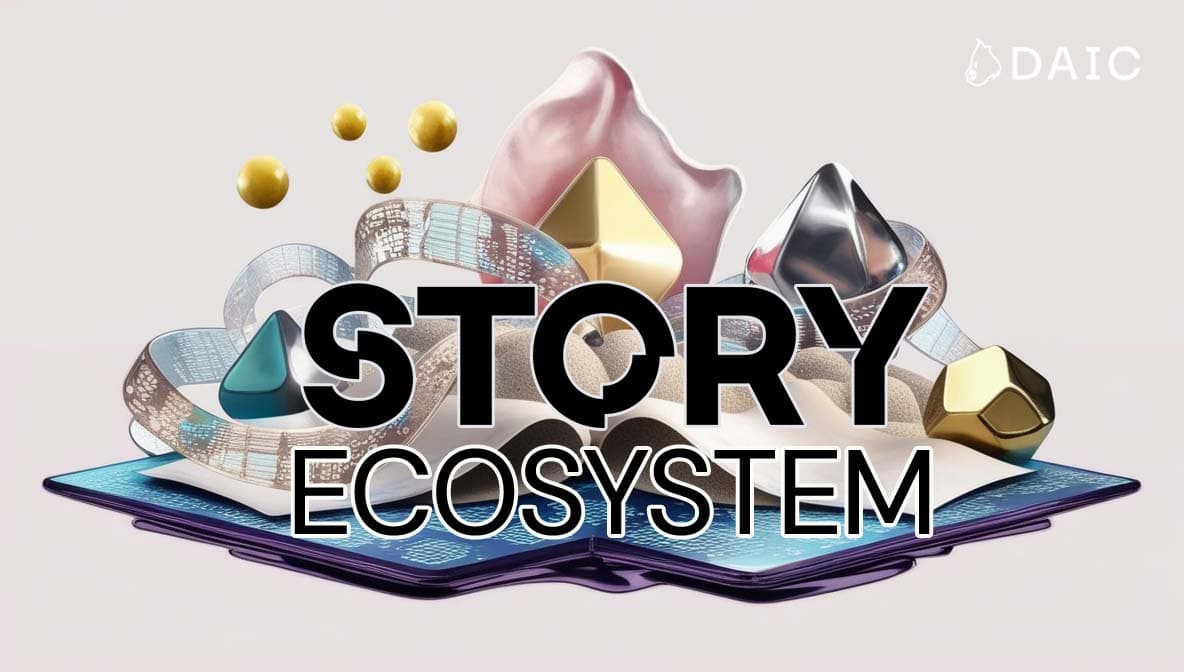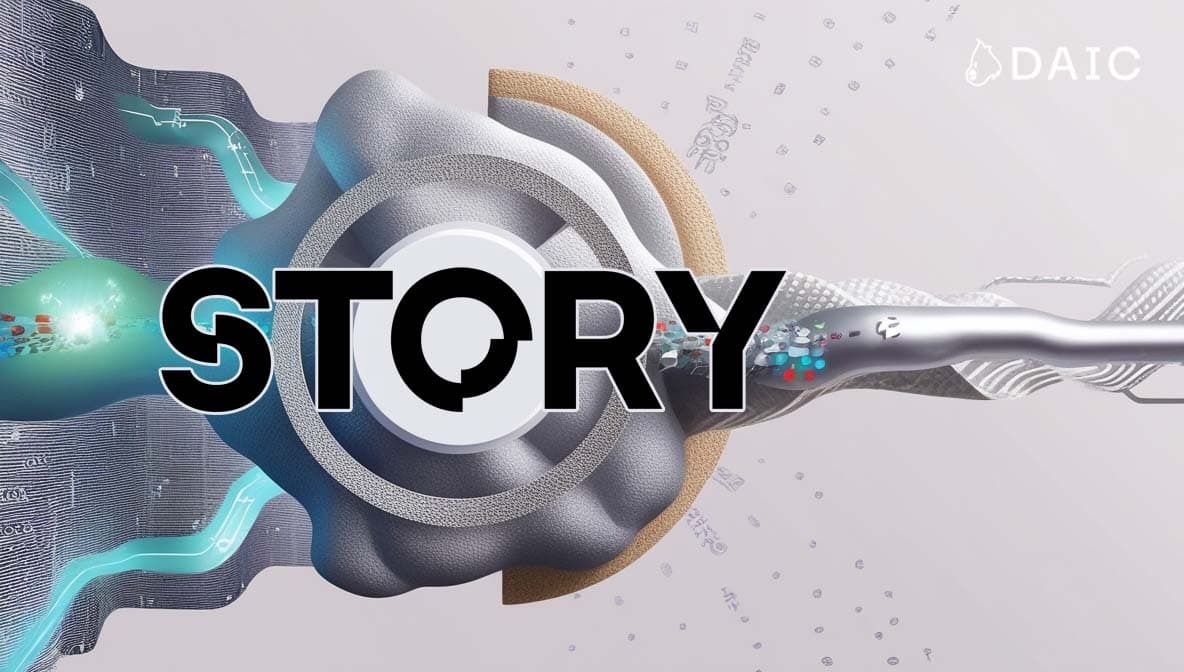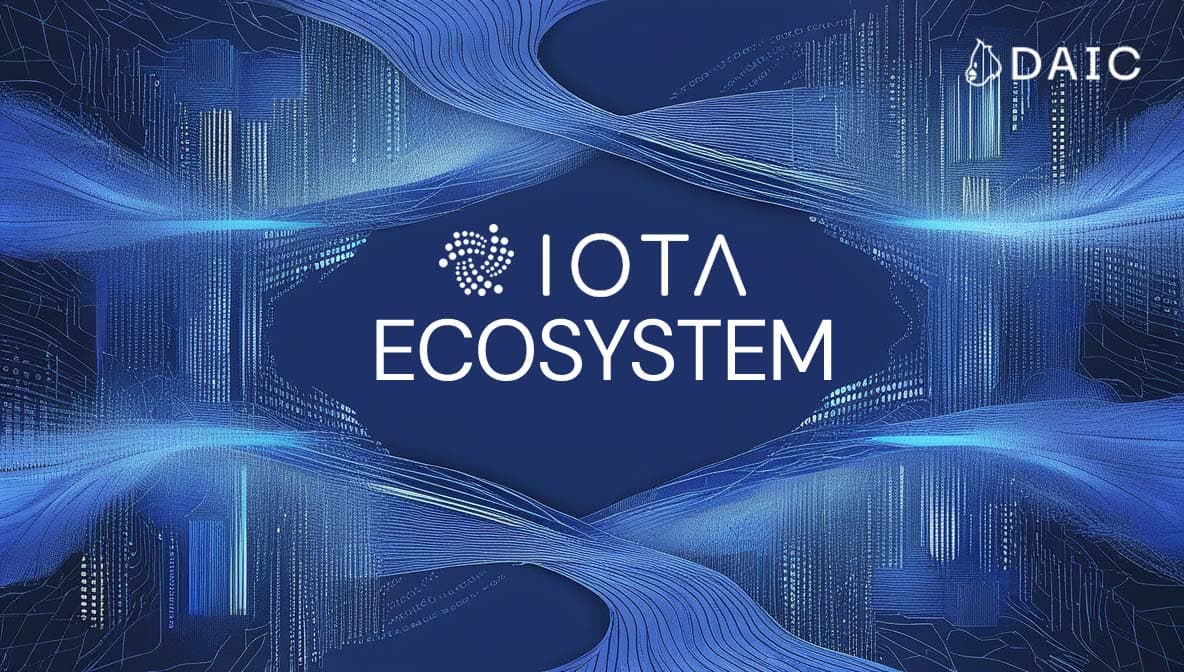Since its launch in 2015, IOTA has been a vision-driven project: to create a new form of distributed ledger technology for a world where devices and humans interact seamlessly and securely. What started out with a focus on the Internet of Things (IoT) has evolved significantly since then. Now, with its latest IOTA Rebased upgrade, IOTA is entering a new era to emerge as a high-performance, programmable, and user-friendly platform for a wide variety of real-world applications. Let us see what drives IOTA and where it is going.
Key Takeaways
- A Bold Revamp: IOTA is a far cry from what it was back in 2015! Find out about its fascinating journey from the original concept to the new IOTA mainnet.
- Tech Made for Today: Discover how fresh underlying tech makes IOTA lightning-fast, much more secure for users, and genuinely decentralized.
- New Way to Participate & Earn: Find out how you can now participate directly through staking and learn about new features that make using dApps easier than ever before.
- Focused on Real-World Value: Notice how IOTA stands out with its extremely strong focus on real-world applications and practical uses.
- An Ecosystem for Everyone: Discover how IOTA enables developers to build on both the most secure technology available (Move) and familiar tooling (EVM), backing innovation directly by grants.
- Innovating for Tomorrow: Get a preview of IOTA's exciting future plans as it continues to narrow the gap between innovative DLT and real-world, practical usage.
IOTA's Journey: From Tangle Webs to a Rebased Reality
IOTA's adventure began back in 2015 with a truly unique idea called the Tangle. Forget the typical blockchain image of blocks being slowly stacked one after another in a neat, single chain. The Tangle was fundamentally different – picture instead a constantly growing, intricate web or mesh of transactions linking directly to each other. Technically, this structure is known as a Directed Acyclic Graph (DAG), but the core concept driving it was revolutionary for its time.
This pioneering spirit was evident from the start, as the IOTA blog notes, "Very early on, IOTA made it its mission to research alternatives instead of iterating on the existing but flawed concepts available at the time." This commitment to foundational research led to over 65 research publications (some of which can be found in docs) as the team worked tirelessly on the protocol.
Key upgrades like Chrysalis refined the network over time. The Stardust upgrade in 2023 was another milestone moment, introducing a multi-asset ledger and, more importantly, laying the groundwork for smart contracts through an EVM-compatible Layer 2 (L2) chain, which rolled out officially in June 2024. This L2 chain rapidly demonstrated the necessity of programmability within the IOTA realm, picking up well more than 30 dApps in short order, as well as accumulating decent on-chain activity.
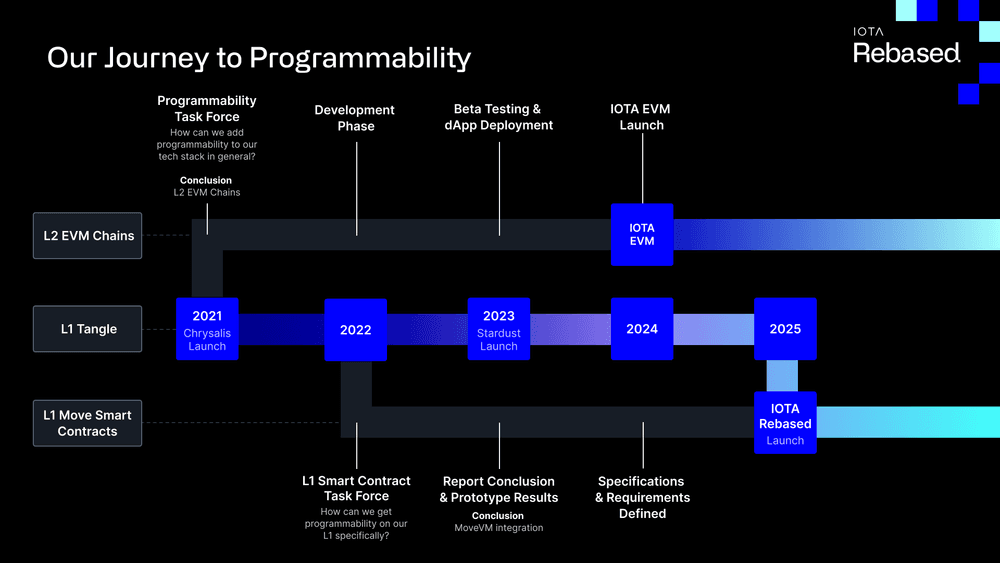
However, the IOTA Foundation, reflecting on nearly a decade of experience and the evolving demands of industry partners and builders, recognized an opportunity to accelerate its core mission. The original IOTA 2.0 roadmap, while promising full decentralization and L1 programmability, was a multi-year research endeavor. To get these critical features to market faster and more effectively, the "IOTA Rebased" proposal was introduced in late 2024. This was a strategic pivot: instead of building everything from scratch, IOTA would "rebase" its Layer 1 by integrating Sui’s battle-tested, robust MoveVM, radically accelerating the time to market for a fully decentralized, programmable mainnet.
The Foundation believed this new direction offered the best chance to "leapfrog" IOTA's market position and create substantial value for its token holders and the broader ecosystem. The IOTA community overwhelmingly validated this vision, approving the Rebased proposal in a governance vote in December 2024.
The launch of the new IOTA Mainnet has set a clear focus on the project's ambitions. The primary aim is to provide a high-performance Layer 1 network where developers can natively build sophisticated and secure dApps, addressing the industry requirement for scalable and programmatic infrastructure.
Beyond specific features, IOTA is deeply invested in delivering real-world utility. The intention is to create solutions that are more than mere speculation and are targeted at actual-world issues in international commerce, digital identity, sustainability, and other enterprise markets. Looking ahead down the road, while IOTA Rebased presently has the MoveVM on L1 and the capacity to natively use EVM on L2, the vision is a world where there is a multi-VM adaptable Layer 1. Perhaps even taking the capabilities of natively having EVM in the core protocol. Behind all of these initiatives is the one-track mind of complete decentralization through its Delegated Proof-of-Stake architecture.
The Technology Behind IOTA Rebased (Simplified)
So, what's under the hood of this revamped IOTA? The Rebased mainnet cleverly brings together a bundle of cutting-edge technologies, drawing inspiration from well-proven solutions and adding its own twist, with the goal of speeding up performance, security, and usability.
The process by which the network reaches consensus on transactions and stays secure has been shifted to Delegated Proof-of-Stake (DPoS). Now, the holders of the IOTA token delegate their "voting power" to trusted validators, and these validators work together to process transactions honestly. Moving away from individual central points of control was a crucial step towards becoming fully decentralized.
Keeping things running smoothly and incredibly fast is the Mysticeti consensus protocol. Inspired by cutting-edge designs (like those used by Sui), Mysticeti employs a smart internal structure (DAG) that allows it to process many transaction blocks simultaneously, in parallel. This architecture is designed for minimal delay and maximum transaction capacity.
Perhaps the most exciting change for developers and the future of applications on IOTA is the direct integration of the Move Virtual Machine (MoveVM) onto Layer 1. Move was built from the ground up, with security at its core (originating from Meta's Diem project). This focus on safety makes building complex applications less risky. The way Move interacts with IOTA's underlying "object model" (where assets are distinct objects owned by accounts) also contributes to both security and the network's ability to process transactions in parallel.
Since most developers are already familiar with Ethereum tools, IOTA Rebased adopts a Dual VM strategy. While secure MoveVM powers Layer 1, the existing EVM-compatible Layer 2 chain can operate unhampered. This gives developers the choice to build next-generation dApps on Move on L1 or just port their existing EVM-based applications onto IOTA's L2.
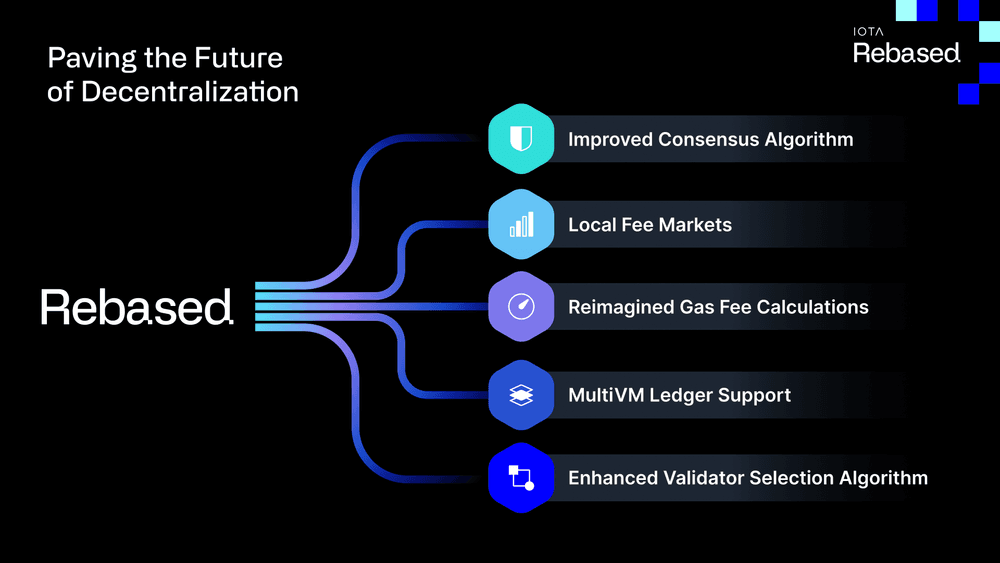
This combination of technologies delivers a powerful set of features for users and builders:
- Powerful L1 Smart Contracts: Build sophisticated, secure dApps directly on IOTA's main network using the modern and safety-focused Move language.
- Developer Freedom (Dual VM): Enjoy ultimate flexibility with support for both the secure MoveVM on Layer 1 and the popular EVM on an integrated Layer 2 chain (with plans for even tighter Multi-VM integration on L1 in the future!).
- Genuine Decentralization: The network is secured by an open Delegated Proof-of-Stake (DPoS) system, aiming for 150 permissionless validator slots, putting control firmly in the hands of the community.
- Blazing Fast Performance: Experience impressive speed with the Mysticeti consensus protocol, targeting over 50,000 transactions per second (TPS) and transaction confirmations in under half a second.
- Smart & Low Fees: Benefit from minimal transaction fees designed for affordability. Plus, a unique fee-burning mechanism helps balance the token supply dynamically (sometimes inflationary, sometimes deflationary!).
- Feeless User Experience (Sponsored Transactions): Interact seamlessly with many dApps thanks to the IOTA Gas Station, which allows developers to sponsor your transaction fees – potentially making it feel truly effortless for users.
- Earn Staking Rewards: Put your IOTA tokens to work! By staking (delegating) them to help secure the network, you can earn passive IOTA rewards.
Fueling the Network: Understanding IOTA's Tokenomics
So, what is the economic force driving the IOTA Rebased network?
It centers fundamentally on the IOTA token, which serves several critical functions within the ecosystem. It is the asset used for staking – where token holders delegate to validators to help secure the network and earn rewards in return. The IOTA token is also used for paying transaction fees (gas) that cover the computational costs and on-chain data storage associated with network operations. Naturally, it facilitates straightforward value transfer, and importantly, it empowers token holders with the right to participate in network governance through on-chain voting.
One of the unique aspects of IOTA Rebased tokenomics is the dynamic supply. Unlike networks with a fixed cap, the total number of IOTA tokens fluctuates. When the Rebased mainnet launched, 4.6 billion existing tokens were migrated. From that point, 767,000 new IOTA tokens are minted each epoch (approximately 24 hours). This minting process primarily funds the staking rewards, introducing a controlled inflation (initially targeted around 6% annually). To counterbalance this inflation, a portion of the transaction fees – specifically the "reference gas price" component of computation fees – is burned, meaning permanently removed from circulation. This creates a deflationary pressure. Consequently, the total supply of IOTA adjusts over time based on the interplay between the consistent minting for rewards and the variable amount of tokens burned through network usage. This design means there is no predetermined maximum supply for IOTA.
Another key component is the system for refundable storage deposits. When users store persistent data on the ledger (such as creating digital assets), they make a deposit in IOTA tokens. This deposit is 100% refundable when the associated data is deleted and the storage space is freed. This mechanism provides a direct economic incentive for users to manage on-chain storage efficiently, helping to keep the ledger lean and performant. The integrated system - using the native IOTA token for fees, staking rewards, and refundable storage deposits - replaced earlier, more complex plans from the IOTA 2.0 concept that involved a separate “Mana” resource token.
The Guiding Hand: The IOTA Foundation
The IOTA project is directed by the IOTA Foundation, a non-profit organization with main registration in Germany and a global operation scope spanning Switzerland and the UAE. The Foundation is the main driver of research, development, and standardization of the IOTA protocol. It also plays an important role in public education, building an active developer community, and promoting the adoption of IOTA technology on an industrial level.
Helmed by key figures like Co-Founder and Chairman Dominik Schiener, the IOTA Foundation is a large, internationally spread workforce (around 140 team members) of researchers, engineers, and experts. It has positioned itself as a reputable and trustworthy R&D organization, attaining significant partnerships with governments and institutions globally. Its mission is to develop open-source, production-ready software and build an ecosystem where IOTA's vision of an interconnected, trustworthy digital world can become a reality.
Beyond the Tech: IOTA's Ecosystem in Action
IOTA is less about hip technology, it's dedicated to developing a successful ecosystem that uses this tech to deliver practical solutions to the real world. The focus naturally is on linking the physical and digital worlds in beneficial manners.
The IOTA Foundation is building the tools and key relationships, including the integration with regulated custodian Zodia Custody, allowing institutions to move assets like financial instruments or real estate onto the blockchain safely, making them accessible. To this, IOTA adds its ongoing business of streamlining international trade. Initiatives like TLIP and TWIN, developed in partnership with collaborators like the World Economic Forum, are putting complicated supply chains on the blockchain to streamline international trade and make it more transparent.
In addition to these flagship missions, IOTA technology has numerous other applications. Think of Digital Identity solutions based on verifiable credentials for secure, privacy-respecting interactions (e.g., tokenized KYC), or Digital Product Passports that assist with sustainability by documenting a product's life cycle.
The wider DeFi and dApp ecosystem on IOTA is also ready to grow. IOTA EVM L2 already has support for a vast range of applications. With the additional capability and security of MoveVM on Layer 1, the potential for increasingly sophisticated DeFi offerings, such as on-chain order books and native stablecoins, is immense.
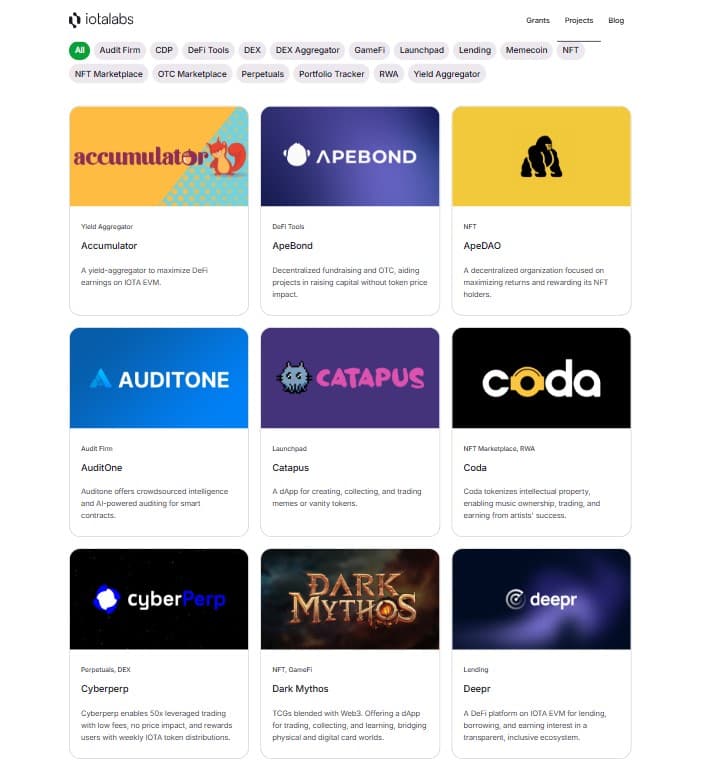
This thriving community does not happen by chance. IOTA is working actively to support innovation through targeted grant programs and initiatives that support developers and entrepreneurs in building the future in IOTA.
Building the Future: IOTA's Next Steps and Your Toolkit
The IOTA Rebased upgrade is a giant step, but to the IOTA Foundation it's a powerful new start and not the finish. They're already conceptualizing a plan for even greater innovation to further enhance the network. Top of the agenda is looking at more reliable consensus mechanisms, hoping to make it more secure and achieve even higher throughput than today's impressive targets, especially as the network becomes more decentralized.
The team is also thinking about making gas prices more fair and dynamic, perhaps through algorithms that automatically respond to network congestion, and exploring local fee markets. Validator selection will also be improved, so it will be easier for new, competitive validators to join and keep the network healthy and decentralized.
Tooling Up for Success
Aside from these core protocol developments, IOTA is bringing on a whole new suite of solutions – a "product arsenal" – designed to make the use and creation of IOTA Rebased effortless and efficient:
- New Wallet Experience: Introducing the IOTA Wallet Browser Extension, the welcoming next-generation of the old Firefly wallet. It will run alongside the IOTA Wallet Dashboard (web application) for handling tokens, staking, and assets.
- Hardware Wallet Support: Security-minded users will welcome support for Ledger hardware wallets through a new independent Ledger app designed particularly for use with IOTA Rebased.
- Smooth Asset Management: Special Move packages have been created to simplify the process for developers to use assets brought over from the previous Stardust network.
- Developer Kits & Tools: Fresh SDKs (Software Development Kits) for Rust and TypeScript are released, in addition to an entire CLI (Command-Line Interface) tool to handle the network and smart contracts.
- Improved Identity: The IOTA Identity system has been reworked to seamlessly integrate with the new Move-based Layer 1, enabling secure and decentralized identity solutions.
- Rebased Explorer: A completely new IOTA Rebased Explorer offers rich insights into network activity, transactions, blocks, and validator performance.
This focus on innovation in future protocol and robust, user-friendly tooling shows IOTA's commitment to building a platform that is not only packing power but is also practical and accessible to all that are building the future of Web3.
Wrapping Up: IOTA Rebased and Ready for Action!
What's the big picture with IOTA today? The shift to the IOTA Rebased mainnet wasn't just a tech upgrade, it was a really smart, practical move. It shows IOTA is serious about keeping pace with the fast-moving world of Web3 while staying absolutely focused on its original goal: making blockchain useful in the real world.
By cleverly adopting powerful, proven technologies like the super-secure MoveVM and the speedy Mysticeti consensus, refining its economic model (hello, staking rewards and fee burns!), and putting a strong emphasis on supporting developers and ecosystem projects, IOTA has set itself up to truly accelerate its journey. This strategy meant getting crucial features like Layer 1 smart contracts and full decentralization out the door much quicker than originally planned.
What does this mean? It means IOTA can now better support its amazing network of partners working on everything from streamlining global trade to tokenizing real-world assets and building secure digital identities. Sure, the blockchain world is competitive, but IOTA has some strong cards to play: a fresh and powerful tech foundation, a clear focus on tangible applications (not just hype), and the fact that most of its tokens are already circulating (no massive VC unlocks looming). It makes IOTA a genuinely compelling project to keep an eye on as it embraces this exciting new era of growth and practical innovation.
The information provided by DAIC, including but not limited to research, analysis, data, or other content, is offered solely for informational purposes and does not constitute investment advice, financial advice, trading advice, or any other type of advice. DAIC does not recommend the purchase, sale, or holding of any cryptocurrency or other investment.
